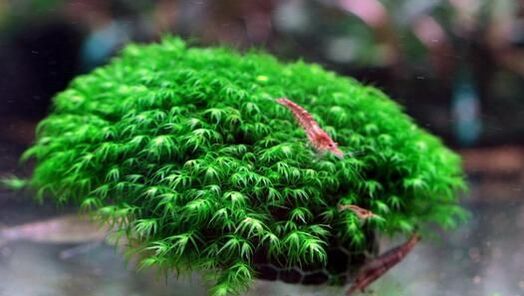Info & Care
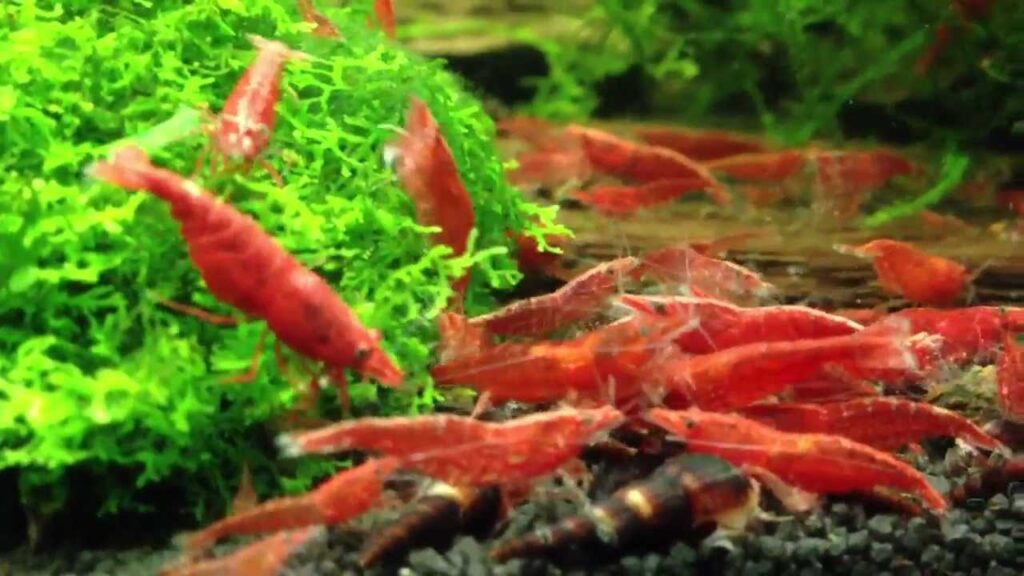
Cherry Shrimp
the back. Most babies turns red when
they are young.
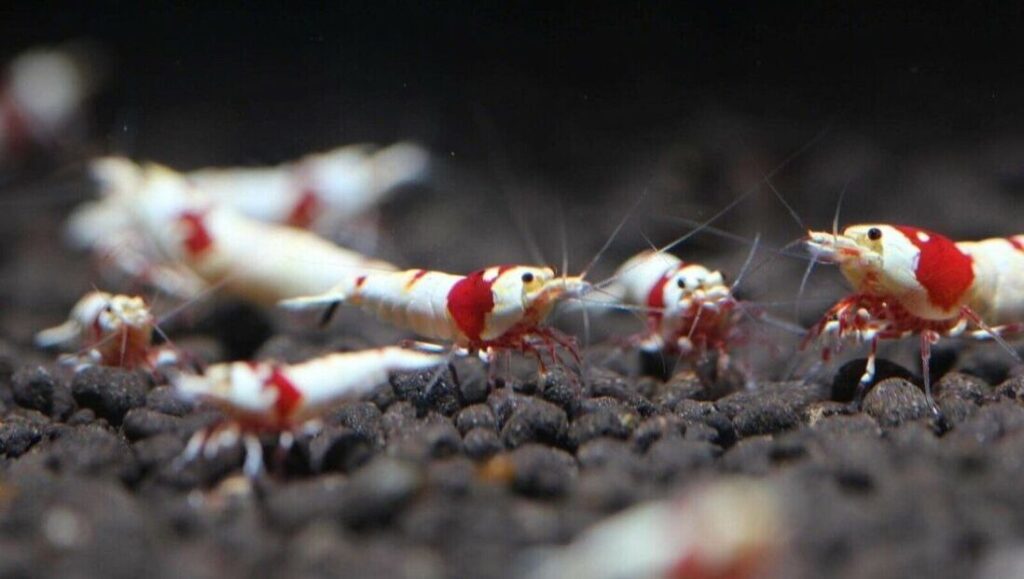
Crystal Red Bee Shrimp
We carry PRL (pure line) red bee shrimp.
They are stunningly beautiful. Low maintenance,
but very sensitive to water parameter changes.
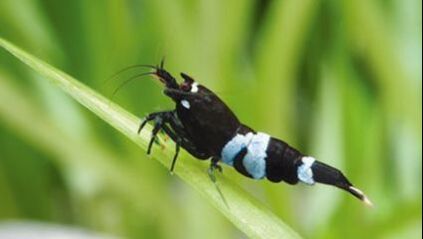
Panda Shrimp
Different variety of bee shrimp.
They are awesome to look. Low maintenance,
but little sensitive to water parameter changes.
Best not to keep with other bee shrimp.
How Copper Affects Dwarf Shrimp
Today I would like to talk about Copper (Cu) and how it affects dwarf shrimp. This is a very delicate subject because any mistake here can take the lives of our shrimp. Everybody knows that copper is extremely dangerous for shrimp and snails. They are very sensitive to this chemical element. However, I do not take anything for granted. I need to know the details.
That is why I started asking questions. Why is copper dangerous? How exactly does it affect the shrimp? What is the dangerous level for Caridina and Neocaridina shrimp? Is the dangerous level the same for all dwarf shrimp? Unfortunately, popular shrimp blogs and websites have close to zero information about it. Thus, I start the search from the scratch myself (well, this is not the first time I do it) and I have found some very interesting information.
First of all, copper (Cu) is a crucial trace element for shrimp because it is an essential part of their blood. However, copper is also a potentially toxic substance for them. All studies have shown that shrimp are adversely affected when exposed to high concentrations of copper. Exposure to high copper disrupts respiration, inhibits reproduction, reduces fertilization success, decreases fecundity, and puts pressures on the immune systems of the shrimp. The chronic exposure to copper sulphate produced blackening of gills in Caridina shrimp, which can be seen even through the carapace.
The problem is that the limit between the requirement and toxicity of copper is delicate and dependents on a variety of factors.
Copper and Dwarf Shrimp’s Blood
As I have already said, Copper (Cu) is a crucial trace element for shrimp because it is an essential part of hemocyanin. Like a human body needs iron for oxygen delivery in the “blood system“, shrimp utilize hemocyanin as the oxygen-carrying pigment which has an analogous role to hemoglobin.
It has been estimated that, on a fresh-weight basis, approximately 40% of the whole-body copper load in shrimp is found in hemocyanin. Thereby indicating the tremendous significance of meeting copper requirements in shrimp.
Interesting fact: According to some researchers, under different physiological conditions, shrimp can regulate their body copper concentration, which is required for hemocyanin synthesis.
Dwarf Shrimp and Copper Supplementation
There are only two ways for shrimp to obtain copper. They can get it from ambient water or diets. Nevertheless, studies also showed that copper in the rearing water alone cannot meet the requirements. Therefore, dietary copper supplementation is essential for shrimp to meet the need for optimal growth, tissue mineralization, and reproduction.
Biologists distinguish inorganic sources (forms of copper) and organic sources (forms of copper). The organic sources are more stable in the digestive tract and less prone to interactions and antagonisms as they are bound to organic molecules and less accessible to interaction and binding.
Some studies have proved that dietary copper has a vital role in the innate immune response in shrimp. While chemical forms of copper affect its absorption and utilization.
Copper concentration and Dwarf Shrimp
Now I have come to the most important part. What is the dangerous level of copper to the dwarf shrimp? Is the dangerous level the same for all dwarf shrimp?
If you search it on Google, the only good link will be to the “Theaquariumwiki”. It states that the dangerous level of copper for:
- shrimps is 0.03 mg/l (mg per litre).
- algae and bacteria is 0.08 mg/l.
- some fish, snails, and plants are 0.10 mg/l.
Unfortunately, there is no information and references for the source of this data.
Note: If we look at Seachem Cupramine, it says “most fish tolerate Cupramine to 0.8 mg/l, it is not advisable to exceed 0.6 mg/l”. As we can see, we already have some significant differences in numbers.
Frankly saying, I spent several days trying to find official studies and reports. Out of a dozen studies, there is only one, which gives us the direct answer we need. The study is called “Histological Changes in the Gills of Two Freshwater Prawn Species Exposed to Copper Sulphate” (January 1979).
According to the experiment, shrimp of the approximately same size (Macrobrachium ~6 cm and Caridina ~2.5 cm) were exposed both to copper sulphate solutions. The results revealed that copper is highly toxic to both species of shrimp. Hundred percent mortality occurs in 0.5 mg/l concentration. The 48 hr LC50 value comes around 0.3 mg/l. Spontaneous movement and irritated behavior of shrimp were noted at higher concentrations of copper.
Note: LC50 is the lethal concentration required to kill 50% of the shrimp population.
| Therefore, according to this data, the dangerous concentration of copper to the Caridina shrimp can range from 0.24-0.32 mg/l. |
Well, this number is 10 times higher compared to “Theaquariumwiki”!
Can it be a mistake?
Copper Sulphate and Aquatic Inhabitants
As I have already said, I have read many studies and reports, and if we look at some other results it can let us better understand the problem. Let me give you some other examples of how copper affects aquatic inhabitants.
| The LC50 values of copper sulphate | ||||
| 24 hr | 48 hr | 72 hr | 96 hr | |
| Macrobrachium lamarrei (freshwater shrimp, average length 6-8 cm (2,3-3,1 inches)) | 0.380 mg/l | 0.361 mg/l | 0.342 mg/l | 0.304 mg/l |
| Macrobrachium dayanam (freshwater shrimp, average length 4-5 cm (1,5-2 inches)) | 1.634mg/l | 0.988 mg/l | 0.532 mg/l | 0.418 mg/l |
| Macrobrachium rosenbergii (30 cm or 12 inches) | 0.6 mg/l | 0.55 mg/l | 0.45 mg/l | 0.35 mg/l |
| Peneid Shrimp (Metapenaeus ensis, average length up to 19 cm (8 inches) | – | 0.16 mg/l | – | – |
| Apple snail (Pomacea paludosa) | – | – | – | 0.024 – 0.027 mg/l |
| Paratya australiensis (Australian Glass Shrimp, freshwater shrimp, average length 3.5 – 4.5 cm) | – | 0.043 mg/l | – | 0.034 mg/l |
| Litopenaeus vannamei Shrimp (average length up to 23 cm (9 inches)) | After 15 days the survival in: – 0.01 mg/l – 100% – 0.05 mg/l – 100% – 0.10 mg/l – 98% – 0.50 mg/l – 43% | |||
Australian Glass Shrimp (Paratya australiensis) showed less tolerance to copper. Its dangerous level of copper coincides with “Theaquariumwiki” (0.03 mg per liter).
Note: In general, the mortality of tested aquatic species is greatest under conditions of low water hardness, starvation, high water temperatures, and among early developmental stages.
Warning:
As we can see, all shrimp species have different susceptibility to copper. Even within the same species, the tolerance can be different because of the size and molting stage (see later). Unless we get more studies regarding specific species (Neocaridna and Caridina shrimp), it is not possible to determine the real threat of copper to dwarf shrimp.
Therefore, we still have to play very safely. However, this data gives some hope to believe that dwarf shrimp can be tougher than we initially thought.
Caution should be exercised against water source contamination and exposure to fertilizers in shrimp tanks as well.
Copper Intoxication signs and behavior of Dwarf Shrimp
Peculiar behavioral alterations have been observed almost in all shrimp species after exposure to copper sulphate during the copper toxicity tests.
- At first, shrimp quickly respond in the form of increased movement.
- They can also start scrapping of body parts.
- The increased surface movements can be observed in the first few hours of the exposure. Although, it usually normalizes within 24hr of exposure, thereafter animals settle on the bottom of the aquarium.
- The mucus production on the gills starts after 24hr of exposure and is maximum after 96hr (covering almost all the body parts). Biologists believe that the mucous secretion may be an important factor to combat the toxic effects of the copper solution.
- Some shrimp species have the blackening of the undersurface of the carapace (just above the gill region).
- After 72 hours shrimp become sluggish with decreased scrapping and respond feebly to gentle paddling.
- After 96 hours reduction in all activities up to maximum lethargicness. At this point, there are certain alterations in muscle fibers.
Accumulation and Storage of Copper in tissues of Dwarf Shrimp
For many freshwater shrimp and crayfish, whole-body and individual tissue loads of copper increase at rates that are approximately proportional to the copper concentration in the water and to the duration of exposure (often over many months). This indicates that excretion rates are very low relative to uptake rates.
For example, copper, which was steadily accumulated by freshwater crayfish, over a period of 8 weeks, was lost again over a similar time course in clean water. Biologists believe that the haemolymph (the blood) acts as a transport system for copper in these crustaceans but is not a site for accumulation.
Shrimp, Copper, and Molting
Protein, hemocyanin, and copper concentrations in the hemolymph of shrimp fall steeply at the molt. The decrease often starts just before molting, reaching a minimum in post-molt stages, and is followed by a gradual recovery through the inter-molt and pre-molt stages.
For example, Australian Glass Shrimp (Paratya australiensis) had a decreased molt period of 23 days (range 20-27 days) vs. 25 days (18-36 days) in 0.015 mg/l.
Another example, shrimp Litopenaeus vannamei:
– 0.05 mg/l (safe level) – accelerated the molting process.
– 0.1 mg/l (safe level) – accelerated both the molting and reproduction cycle.
These results provide strong evidence that a trace amount of copper is an essential part for both molting and reproduction in shrimp. In addition, recent biochemical studies have certainly shown that changes in hemocyanin synthesis are correlated with particular stages of the molt cycles.
However, there are still many gaps in the overall picture of the metabolism of copper and hemocyanin in shrimp.
Copper and pH in a Tank
In alkaline water (high pH), copper ions bind to calcium carbonate (KH). Therefore, the amount of free copper ions in the water decreases. However, if the pH drops, the poisonous copper ions will be released again.
This is extremely important, because a safe concentration of copper at higher pH may become a lethal dose at a lower pH.
At low pH levels, the water is poorly buffered and copper can become very toxic.
Fertilizers, Copper, and Dwarf shrimp
A lot of shrimp tanks also have plants. Therefore, aquarists often ask, can they use fertilizers? Which ones are shrimp safe? The problem is that almost all of them contain copper and most shrimp breeders are paranoids when it comes to the safety of their shrimp colony. Especially when they hear the word Copper.
I know for sure, that the absolute majority of professional shrimp keepers never use plant fertilizers in their shrimp tanks. Shrimp are too sensitive and nobody wants to take any risk (even the smallest).
I have looked through the most popular plant fertilizers and picked the safest for the shrimp. Although, they do contain copper, the amount of it is minuscule. This is the list.
1. Seachem Flourish
Seachem Flourish contains a rich assortment of important micro elements, trace elements, and other nutrients. These include calcium, magnesium, iron, copper (0.0001%), and other important elements to aquatic plants and shrimp as well.
contains a rich assortment of important micro elements, trace elements, and other nutrients. These include calcium, magnesium, iron, copper (0.0001%), and other important elements to aquatic plants and shrimp as well.
According to Seachem, Flourish is safe for invertebrates such as shrimp. I quote from the official site “Yes, Flourish® is safe to use with shrimp. It is true that in large amounts, copper can be toxic to aquatic animals and invertebrates like shrimp and snails can be particularly sensitive. However, copper is needed in trace amounts by both plants and animals, including shrimp, which is why we include it in Flourish, Flourish® Trace, and our other Trace products. The amount of copper in Flourish® is so small that you would have massively overdose before you would begin to approach an amount of copper that is toxic to even the most sensitive animals. There is usually much more copper in tap water than there is in Flourish”.
2. Dennerle series of fertilizers
 Dennerle is a world-known German company producing aquarium and pond supplies. They are working with Shrimp King (Chris Lukhaup) himself. Dennerle has a wide variety of pretty much everything you need, including (as they say) shrimp safe fertilizers.
Dennerle is a world-known German company producing aquarium and pond supplies. They are working with Shrimp King (Chris Lukhaup) himself. Dennerle has a wide variety of pretty much everything you need, including (as they say) shrimp safe fertilizers.
Quote “We often hear that fertilizers are bad for shrimps… But when these products are used correctly (right product at the right dose), they are not dangerous at all! All the Dennerle fertilizers are shrimp safe. Even the iron, with our E15 FerActiv!“
This is what they advise for the shrimp tanks: Dennerle E15, Dennerle V30 Complete, Dennerle A1 Daily, Dennerle S7 Vitamix.
3. JBL series of fertilizers
 JBL is another German company, which supplies 60 countries worldwide with a product range of over 1000 products.
JBL is another German company, which supplies 60 countries worldwide with a product range of over 1000 products.
According to them, I quote from the official site “The concentration in JBL Ferropol, JBL Ferropol 24 and JBL ProScape Fe +Microelements is so designed that all trace elements are available in the required quantities. Not even multiple overdosing of the fertilizers can lead to consequences with shrimps and other decapods”.
4. Biovert Plant Fertilizer
Biovert Plant Fertilizer  provides all the trace elements you need to ensure healthy plant growth.
provides all the trace elements you need to ensure healthy plant growth.
But the most important for us is that it is shrimp safe. Do BioTrace and BioVert contain copper? Is this copper could be a problem for invertebrates like shrimps?
I quote “The quantity of copper in these products is low and below the dose harmful for shrimps. The products can be used without fear and under conditions noticed on the packaging”.
5. Sera florena
According to them, it is well tolerated by all invertebrates. However, they do not tell us how much copper this fertilizer has.
Sera Florena .
| Note: You need more information about different products, read my article “Shrimp Safe Plant Fertilizers”. There is a description of the most popular plant fertilizers on the market that will not harm your shrimp or snails as well. |
How to test your Tank for Copper
The main problem here is that many common copper test kits are not sufficiently sensitive. They can often show concentrations that are already deadly for the shrimp. That is why we need to choose test kits, which can work with small concentrations.
We have two main favorites here.
1. API Copper Test KIT (detects copper levels from 0-4 ppm)
- Fill a clean test tube with 5 ml of water to be tested (to the line on the tube).
- Add 10 drops of Copper Test Solution, holding dropper bottle upside down in a completely vertical position to assure uniformity of drops.
- Cap the test tube and shake for 5 seconds.
- Wait 1 minute for the color to develop.
- Remove the cap. Hold the test tube upright over the white area on the color card and view the color of the solution by looking down from above. The closest match indicates the ppm (mg/L) of copper in the water sample. Even a very faint color indicates the presence of copper. Rinse the test tube with clean water after use.
API Copper Test KIT.
2. Seachem MultiTest™ Copper (Range Measures between 0–0.80 mg/L copper)
 Copper kits are usually of two types: compleximetric or titration based. Some kits measure only ionic copper and others measure both ionic and chelated copper. This kit uses a highly sensitive catalytic compleximetric based procedure to measure all types of copper to less than 0.01 mg/L in marine or freshwater. MultiTest™ Copper performs over 75 tests and contains a reference sample for validation.
Copper kits are usually of two types: compleximetric or titration based. Some kits measure only ionic copper and others measure both ionic and chelated copper. This kit uses a highly sensitive catalytic compleximetric based procedure to measure all types of copper to less than 0.01 mg/L in marine or freshwater. MultiTest™ Copper performs over 75 tests and contains a reference sample for validation.
- Fill sample pipette to base of the bulb and dispense to a test cavity of the test plate. Repeat, adding to the same cavity.
- Add 2 drops of Copper Reagent 2.
- Insert the dry Stir rod into the Copper Reagent 1 container to coat the rod with a very light dusting of Copper Reagent 1. Gently tap the rod against the side of the container to shake off excess Copper Reagent 1. Dip Stir rod with Copper Reagent 1 in the test cavity and stir briefly.
- Compare color with color chart within 20 to 30 seconds after stirring. If testing chelated copper, read after 15 to 25 minutes. (Cupramine™ is not chelated.)
- Promptly dispose of completed test solutions by rinsing the test cavity under running water. If the test plate becomes stained, soak or clean with a dilute bleach cleaner, then rinse well.
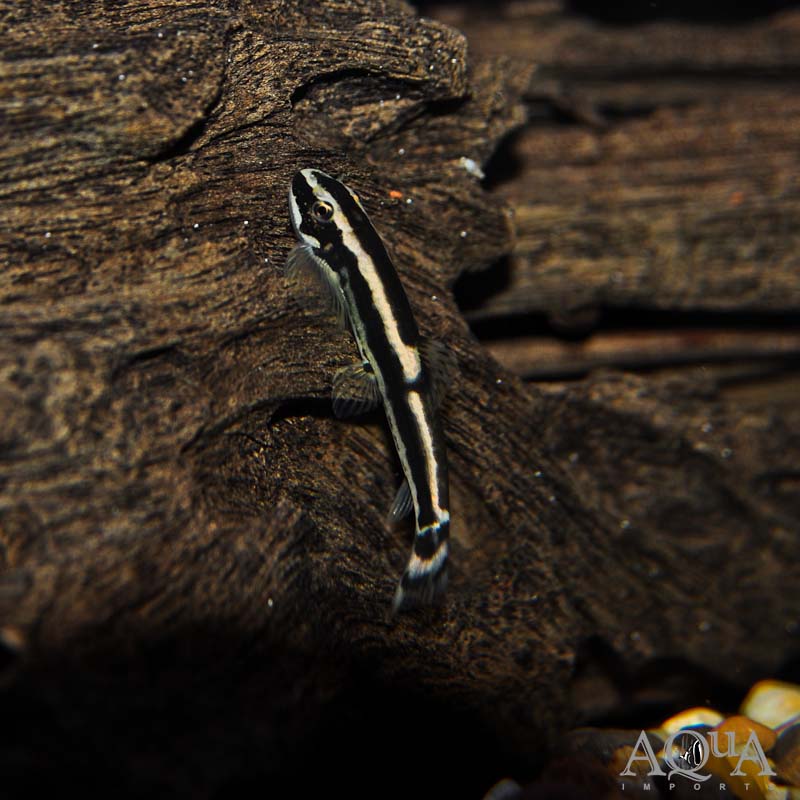
Goldline panda loach
Vegetarian fish, safe with baby shrimp.
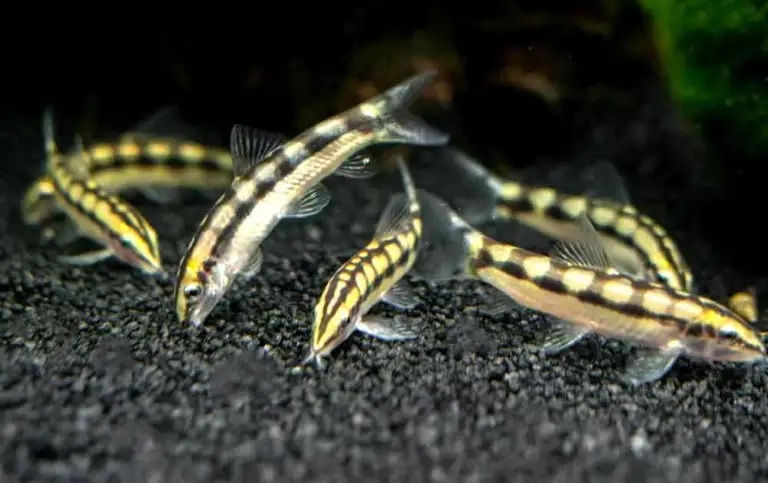
Botia sidithmunki
cool schooling fish, omnivorous and not safe with shrimp.
Breeding panda loach
Success in breeding panda loach
Panda Loach Care
Panda Loach can be a difficult species to care for correctly. They have specific dietary and environmental needs and cooler water temperature requirements. This is a subtropical species, and their care is different than what many hobbyists have come to expect when dealing with tropical freshwater fish. If you are planning on keeping this rare and finicky fish, there are some facts you’ll need to know first. Let’s find out more!
Temperature
A subtropical fish, the Panda Loach needs cooler temperatures between 64° – 72° F.
Water pH
Panda Loach prefers slightly alkaline water in a range between 7.0 and 8.0 pH with little to no hardness.
Panda Loach Size
Panda Loach will only reach a maximum size of 3 inches.
Food & Diet
In nature, the Panda Loach is almost entirely herbivorous, mainly eating algae and other plant matter. They will eat algae and biofilms in an aquarium but should be provided with sinking algae wafers. While this species can be omnivorous, there are some signs that a high-protein diet can lead to early death.
Avoid feeding these fish meaty foods or high-protein prepared foods. While they may have loach in their name, the Panda Loach isn’t a natural omnivore like a Clown Loach. They will not harm other tank inhabitants, and this includes snails.
You’ll want to plan for some algae growth in their tank. Provide bright aquarium lights and smooth rocky surfaces to allow algae to grow. Ideally, Panda Loaches should not be placed in new tanks. Mature aquariums with some algae already established are best.
Panda Loach Lifespan
A Panda Loach can live 6 to 8 years with excellent care. For the best health and longest lifespan, don’t feed this species a high-protein diet.
Panda Loach Tank Size
Panda Loach is a smaller fish, and a 20-gallon aquarium should be enough for a small group.
Tank Setup
Panda Loach are native to fast-moving, subtropical mountain streams in China, and their tank environments should try and duplicate these conditions. Provide large rocks and gravel with lots of cover and hiding spaces. This isn’t a particularly shy fish, but they do like to rest under rocky cover.
While Panda Loach can tolerate some alkalinity, they do want soft water. It is best to use RODI or very soft water. This species can acclimate to tap water, but water in their natural environment has very little hardness. Avoid rocks or substrates that contain coral.
While substrates like crushed coral or aragonite sand can buffer alkalinity, they also slowly dissolve and harden the water. Don’t include bogwood or driftwood in your Panda Loach tank, as these woods can raise the acidity of your water beyond what this fish needs. Smooth river rocks and pebbles that won’t change water pH are the best choices for this species.
The Panda Loach originates from fast-moving, rocky streams. You’ll want to ensure your tank has strong currents to keep this fish happy. Often this can come from having powerful filtration. On larger tanks, canister filters can provide strong flow in addition to their main job of filtering water. Panda Loaches are often kept in smaller aquariums that usually aren’t large enough to justify a canister filter system.
For these tanks, consider installing wavemakers. These fan-like devices are popular in marine aquariums to create powerful flows for reef fish species. They can also be a good choice in freshwater aquariums when a strong current is needed. A side benefit to all this water flow is oxygenation. This fish needs water with high oxygen content. Anything that keeps your water moving will raise your tank’s oxygen levels. You can also include one or more aquarium bubblers for good measure.
Maintaining proper water temperature is one area where caring for Panda Loaches can get tricky. This is a subtropical fish, so they need a water cooler than you might expect. Depending on your climate and ambient room temperature, you might need to include a chiller to keep water temperatures in line. Different kinds of chillers are available depending on your needs and budget. They range from simpler, self-contained devices attached to your tank to more complicated external units that must be plumbed into the aquarium system.
While Panda Loach will eat prepared foods such as sinking algae wafers, they also enjoy grazing on tank algae and biofilms. For this reason, it is best to add this species to mature tanks. A newly prepared aquarium won’t have the biological diversity to provide supplemental food for this species. Their tanks should also have enough bright light to encourage algae growth. Many LED aquarium light fixtures allow you to adjust the light schedule and brightness.
Once your Panda Loaches are established, adjust the lighting intensity to encourage enough algae growth to provide food for your Pandas without overrunning your tank.
This species also needs much more filtration than most other tropical fish species. The normal recommendation for freshwater aquariums is to have a filter system that can turn over 4 to 5 times the tank volume in an hour. Panda Loach tanks will need filtration capable of turning over 10 to 15 times the tank volume in an hour! This means a 20-gallon aquarium will need a filter that runs between 200 and 300 GPH (gallons per hour). Not only will this help keep the water clean, but it will also create the strong currents this species prefers.
Panda Loach Breeding
Panda Loach are very difficult to breed in captivity. It has been done, but only rarely. If you want to attempt to breed this fish, make sure you have a group of 4 or 5 with only 1 to 2 males. Due to the rarity of successful breeding, detailed information is scarce.
Here is a quick video of 9 Panda loaches heading off to the fish store. My brother has successfully bred them 3 times, each time with about 10 offspring. The key to breeding them is good water quality, driftwood, and various algae available.
Usually, the best you can do is keep their water parameters stable and hope for the best. Panda Loach fry are small and vulnerable to predators. It is best to keep your breeding group in their own tank so other fish don’t eat any resulting fry. Make sure your breeding tank is mature enough to have biofilm and algae growth for the fry to feed on. Also, use sponge filters if possible to avoid filtering out the small, vulnerable fry.
f you’re looking for a unique and fascinating fish to add to your aquarium, look no further than the enchanting panda loach. These small, striped fish have captured the hearts of aquarists worldwide with their peaceful nature and stunning black and white coloration. But, if you’re up for a challenge, why not try your hand at breeding these captivating creatures? Breeding panda loaches may require a bit of knowledge and patience, but the reward of watching the delicate fry grow into beautiful adult fish is well worth the effort. Join us as we dive into the world of panda loach breeding and uncover the secrets to successfully raising these remarkable fish.
| Characteristic | Values |
|---|---|
| Scientific Name | Yaoshania pachychilus |
| Common Name | Panda Loach |
| Origin | China |
| Habitat | Rivers, streams, and ponds with plenty of plants and hiding spots |
| Temperature | 65-75°F |
| pH Level | 6.5-7.5 |
| Water Hardness | Soft to medium hardness |
| Maximum Size | 2 inches |
| Diet | Omnivorous, eats small insects, crustaceans, and plant matter |
| Breeding Type | Egg scatterer |
| Spawning Behavior | Males will chase and nudge females to encourage egg release |
| Incubation Period | 2-3 days (eggs) |
| Fry Care | Fry are independent and should be separated from adults to prevent predation |
| Sexual Maturity | 6-12 months |
| Lifespan | 3-5 years |
Male and Female Panda Loach
Panda Loaches are very difficult to sex correctly. It is best to attempt this in groups of four or more. The females have slightly thicker and fuller bodies than the males.
Panda Loach Disease
Panda Loaches aren’t particularly susceptible to disease, but they are picky about water parameters. Bad water chemistry will kill this fish before it leads to disease. Many tropical fish are tolerant of a range of water parameters but may be more prone to develop the illness if their tanks aren’t clean.
On the other hand, Panda Loaches won’t survive the water quality problems that would normally only lead to disease in tropical fish. To keep this fish successful, make sure and perform regular water changes and keep a close eye on your water chemistry.
Panda Loach Tank Mates
Panda Loaches are easy to get along with and won’t cause trouble for other tank mates. Exercise caution when including other fish species that are more aggressive or which might attack this fish. Good tank mates would include other subtropical fish such as Spanish Killifish, White Cloud Mountain Minnow, Golden Dwarf Barb, and Rosy Barb.
Other algae-eating species, such as Hillstream Loach, are competition for food and may fight. Paradise Fish are another possibility. These fish can be aggressive, but they often stay in upper to mid-tank regions and won’t have much contact with Panda Loaches. This combination must be watched closely for signs of violence against the Pandas.
How many Panda Loach should be kept together?
Panda Loaches enjoy the company and do best in groups of four or more.
Panda Loach and Shrimp
Panda Loach and Shrimp are a great combination. The Pandas will leave shrimp alone even though they eat algae and biofilms.
Panda Loach and Betta
Panda Loach and Betta are a bad combination. The cool water temperatures the pandas need are lower than the lowest temperature that tropical Betta can tolerate.
Panda Loach and Snails
Unlike other Loaches, Panda Loach will not eat snails. This makes for a good pairing in a community tank.
Panda Loach and Goldfish
Panda Loach and Goldfish are a great tank mate combination. Many Goldfish are kept at room temperature, but they prefer the lower temperatures of the subtropical Panda Loach aquarium.
Panda Loach and Discus
Panda Loach and Discus are a bad tank mate combination mainly due to their different temperature requirements. Discus are tropical fish that need much higher temperature water than the Panda Loach can tolerate.
Where Can I Find Panda Loach for Sale?
The Panda Loach is a rare fish and can be extremely difficult to find. Your best bet will be Internet sources. Even online, this fish is often out of stock. Expect to pay $30 to $60 USD each.
Sulawesi Shrimp Care
| Aquarium Size | 10+ gallons (add 1 gallon per 1-3 additional shrimp) |
| Water Temperature | 78-88°F Sulawesi shrimp seem to be more sensitive to light than other species. Most Caradina species do not seem to mind light; Sulawesi shrimp are the exception. Try to keep the lights fairly dim. A darker tank also helps to bring out the shrimps’ colors. Stick with aquatic plants that don’t need a lot of light to survive. (25.6-31.1°C) |
| pH | 7.8-8.2 |
| General Hardness (GH) | 6-8 |
| Carbonate Hardness (KH) | 4-8 |
| Total Dissolved Solids (TDS) | 50-150 |
| Safe Water Levels | Ammonia: 0 ppm Nitrites: 0 ppm Nitrates: <20 ppm |
| Lighting | Prefers dim lighting — sensitive to bright light |
| Decorations | Pebbles RocksCrevices Aquatic vegetationBoiled driftwood |
| Tank Mates | Necessary — groups of 10+ shrimp ideal Other Sulawesi shrimpNeocaridina shrimp Sulawesi snails |
| Diet | AlgaeBiofilm Decaying plant matter |
Sulawesi shrimp seem to be more sensitive to light than other species. Most Caradina species do not seem to mind light; Sulawesi shrimp are the exception.
Try to keep the lights fairly dim. A darker tank also helps to bring out the shrimps’ colors.
Stick with aquatic plants that don’t need a lot of light to survive.
Substrate
The lakes of the Sulawesi region have coarse rocky bottoms. It’s best to replicate this environment.
Substrates safe for Sulawesi shrimp include:
- Crushed lava rock
- Aragonite sand
- River stones
Of the three options, aragonite sand is the best choice. It raises the pH to about 8.0-8.3 to suit the shrimp’s needs. It also adds beneficial minerals to the water, like magnesium and calcium.
It’s better to choose dark substrates to bring out the coloration of these shrimp. Their colors seem to become brighter while living in a dark environment.
Cleaning
Sulawesi shrimp do not like changes to their environment. They don’t need pristine water conditions.
Allow the filter to do most of the cleaning. Their tanks do not need water changes as often as other species.
A tank full of algae and biofilm mimics their natural environment.
Only perform water changes about once every two weeks. Only remove about 15-30% of the water at a time.
Keepers should only do large water changes in emergencies, especially with Sulawesi shrimp. Emergencies include when the ammonia or nitrites are too high.
Removing too much water at once can cause huge fluctuations in the water parameters. Sulawesi shrimp are very sensitive to water changes. The sudden change can cause severe stress and even death.
Avoid overfeeding the shrimp to prevent the tank from getting too dirty.
Most aquarists remove algae from their tank. Don’t remove algae from a Sulawesi shrimp tank, as algae comprise the main part of their diet.
Feeding
These shrimp are omnivorous scavengers that do a good job keeping their home clean. They primarily eat biofilm, detritus, and algae that build up around the tank.
They are ferocious eaters that feed constantly. They always pick at surfaces around the tank. Sulawesi shrimp enjoy scavenging on the rocks around their tank and even on the shells of snails.
Since they are such diligent scavengers, they need very little supplemental food. The more established a tank is, the less caretakers need to feed their shrimp.
Those with new tanks should provide shrimp pellets or algae wafers a few times a week. Remove any leftover food after two hours to avoid it dirtying the tank.
Decaying food causes ammonia to spike. Too much ammonia in the tank is a major cause of illness and death among Sulawesi shrimp.
Breeding
It can be difficult to maintain the unique water parameters Sulawesi shrimp need. Still, they are relatively easy to breed when living in optimal conditions. Aquarists rarely need to encourage breeding as the shrimp will do it independently.
Sulawesi shrimp breed more slowly than other Caridina shrimp. They do not produce eggs as often and lay fewer eggs. Breeders must be patient when working with this species.
Common Health Problems
Researchers aren’t aware of any problems that affect Sulawesi shrimp specifically. Still, they are sensitive animals susceptible to issues common in freshwater shrimp.
The most common issues among freshwater shrimp include:
- Bacterial/fungal/parasitic infections
- Molting trouble
Shrimp that get sick need immediate treatment. Infections spread throughout tanks quickly and can be fatal within hours or days.
* Be cautious when picking treatments for shrimp. They are sensitive to many medications. Avoid medications with copper, malachite green, and CO2. These substances are fatal to shrimp.
Always choose medications that say they are “shrimp” or “invertebrate safe.” It’s best to get recommendations from a veterinarian before choosing a medication. *
Bacterial, Fungal, & Parasitic Infections
Infections of all kinds most often stem from stress. Stress usually occurs because the water parameters are off or the tank is dirty. Water parameters that fluctuate frequently cause stress as well.
Bacteria, fungi, and parasites are ever present in the tank. Generally, they don’t bother healthy shrimp. A shrimp’s immune system lowers when they experience stress. They become more susceptible to infection.
The best way to prevent infections is by keeping the tank clean and the water parameters stable.
Molting Issues
Shrimp must molt to get rid of their old shells and grow new ones. Shrimp don’t grow with their shells like snails do. They must receive the proper amount of calcium to keep their shells healthy. Without enough calcium, shrimp have trouble shedding their old shells.
Shrimp may have issues with their shells when their tank is dirty. Unstable water parameters cause the same issue.
Sometimes, the shell may break at odd angles. While the shrimp usually find their way out, it can be a stressful and dangerous situation.
The most dangerous situation is the “white ring of death.” The shrimp’s shell splits right in half, and it cannot crawl out. Becoming trapped inside the shell, the shrimp eventually dies.
Do Sulawesi Shrimp Interbreed?
Sulawesi shrimp do not interbreed with Neocaridina or other varieties of Sulawesi shrimp. Hobbyists could keep cardinal and blue ghost Sulawesi shrimp in the same tank. They would not interbreed.

